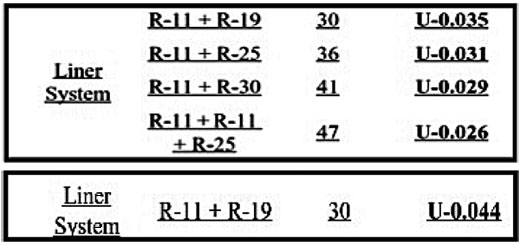Ensuring commercial energy code compliance: A breakdown of the prescriptive assemblies from the 2012 IECC
If you missed part 1 of my “Top Takeaways” blog post, you can read it here.
 Now that we’ve covered the introductory basics on differentiating between IECC and ASHRAE, as well as the information contained in a commercial energy code, we can move on to ensuring that you understand how to meet your state’s latest energy code. The key to compliance is in the prescriptive roof and wall assemblies.
Now that we’ve covered the introductory basics on differentiating between IECC and ASHRAE, as well as the information contained in a commercial energy code, we can move on to ensuring that you understand how to meet your state’s latest energy code. The key to compliance is in the prescriptive roof and wall assemblies.
Takeaway #4: What to Know to Ensure Compliance:
The 2012 IECC Prescriptive Assemblies
Zone 4 walls = R13 ci (Board/Thermax™) + R13 Fiberglass OR U-Factor of 0.052 (installed R-Value of 19.2)
Other options:
- OptiLiner™ (Liner System) R30 (9” fiberglass) and foam tape = U-Factor of 0.049
- Insulation board (thickness dependent on R-Value per inch)
- Insulated panel (thickness dependent on R-Value per inch)
Zone 4 Roof = R19 + R11 Liner System with thermal block OR U-Factor of 0.035 (Installed R-Value of 28.6)
Other options:
-
- Long Tab Banding (filled cavity) R25 + R19 with thermal block = U-Factor of 0.029
- Insulation board or insulated panels (thickness dependent on R-Value per inch)
Takeaway #5: Metal Building Assembly Descriptions
Now that you know where to find the prescriptive assemblies, let’s take a closer look at the most common system used to meet the wall and roof assemblies.
Liner System: Walls
NOTE: Liner System wall testing performed by Owens Corning and can be used for code compliance. Values are NOT found in ASHRAE tables.
It’s important to understand that the wall values as described in the IECC 2012 code are suggested methods to meet the U-Value for that climate zone (i.e. R-13 plus R-13 Continuous). The overall U-Value for this combination is U-0.052. Most builders do not realize that any system Hot Box tested with a U-Value equal to or better than any climate zone U-Value is also allowed. This information can be found in Chapter 4 section C402.1.2 of the IECC 2012 Code.
Liner System: Roof
My most frequently stated tip for better understanding prescriptive roof assemblies is to remember that the assemblies assume a standing seam roof with a thermal block is used. Though it’s fairly straightforward, builders often forget about this underlying assumption.
I hope you’ve found these top takeaways from my MBCEA presentation helpful. Check back in September, when I’ll cover the basics of COMcheck™, which is a widely used tool that helps builders meet the requirements of the IECC and ASHRAE Standard 90.1, as well as several state-specific codes.
Want to make sure you don’t miss out on the latest energy code updates?
Subscribe to our energy code newsletter to get blog posts sent directly to your inbox.
MORE BLOGS
COMcheck™: A Live Demo with Bill “The Code Man” Beals
Join Bill “The Code Man” Beals Thursday, October 26th at 2:15 p.m. ET for a free COMcheck™ demonstration. Participants will earn 1 AIA LU/HSW and/or a certificate of completion.
Mid-Year Energy Code Update
I’ve been on the move and traveling the country, giving energy code presentations and attending industry meetings. In this mid-year energy code update, I’m sharing the trends I’ve observed from state to state, with a focus on the challenges and opportunities the IECC 2021/ASHRAE 90.1-2019 energy code cycle poses for metal building contractors, erectors, and designers.
Commercial Energy Codes & MBI: What to Know In 2023
Happy 2023, folks. We’re kicking off the new year with something a little different: A video summary of the current energy code landscape, plus what you need to know as we move into 2023. I also cover the metal building insulation systems that meet the most...
This Just In: Several States Adopt New Commercial Energy Codes
It’s officially the start of fall, folks, and you know what that means: A quick commercial energy code wrap-up. Here’s a short-and-sweet update on what’s been happening around the country. Also, are you attending METALCON? Join me for a free AIA-accredited course on...
Commercial Energy Code Update: What to Know for 2022
Learn more about the top commercial energy code updates you need to know for 2022.
2020 Code Update: Taking A Look At The Remainder Of The Year
Let’s dive into the top building envelope code updates you need to know for the rest of 2020.
Metal Buildings & Energy Codes: A Webinar With The Code Man
Join me Thursday, November 14th at 1 p.m. ET for a free webinar on the metal building envelope code changes you need to know. Participants will earn 1 AIA LU/HSW and/or a certificate of completion.
2019 Commercial Energy Codes Update
I got together with the folks at Metal Construction News and Metal Architecture to organize a webinar that will summarize the key commercial energy code information I’ve talked about over the past year.



